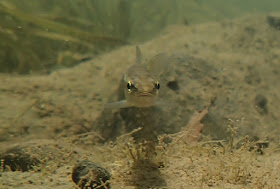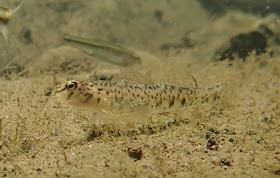The dog days of summer bring out some of the best topwater bites for smallmouth bass. All topwater lures can be productive at one time or another, but when the fish are aggressive, buzzers or prop baits are tough to beat and a heap of fun to fish. Why? They create a disturbance that aggressive bass can't resist and they cover a lot of water. That's a formula for some pretty good numbers, wouldn't you agree? Not only that, they're big fish baits too.
 |
| Mid summer river conditions like this just scream topwater to me, and my go to topwater baits are either a buzzbait or prop bait. |
It doesn't matter to me if I'm fishing from my boat or wading, because when the fish are on this type of bite, it's quite exciting. If I start off fishing low light conditions, I'll opt for a topwater lure of some sort, and for me, I like to cover water quickly, so it's either a buzzbait or a prop bait to get those aggressive biters that are a little less wary at that time. Normally during mid-day, I'll work soft plastics, but, if I see signs of bass feeding on the surface or chasing minnows in the shallows, then I'll break out my topwater lures and give them a go. Hungry summer bass may be aggressive even in the mid day heat.
 |
| My buddy Howard and I with a double, both caught on buzzbaits. Nice size bass like these are so much fun when they crush topwater lures. |
I find that both buzzbaits and prop baits are equally effective for provoking strikes, but river conditions and the mood of the fish dictate which one I'll pick. If weed growth is abundant, then the buzzbait is a bit more effective because you can fish right through most weeds and draw strikes without getting the lure fouled. I'd rather spend more time with my lure in the strike zone than having it out of the water cleaning it off. Prop baits are weed collectors.
 |
| This chunky river smallie attacked my buzzbait! |
However, if the water is up and the weeds are submerged, or perhaps, like in certain years, weeds aren't as abundant, prop baits seem to result in a better hook up ratio. I don't think fish key on either lure over the other very often, but there are times when they slurp rather than crush the lure, and the prop baits work better in that situation, it seems, at least for me.
My go to buzzbaits for smallies are the 1/8 ounce Strike King or a similar buzzbait. I beef them up by adding an old 4" ringworm as a trailer as it seems to trigger larger bass to strike than without the trailer. When it comes to color choice, many folks local to me go with white, especially this time of year to match the white miller mayfly hatch. That works great for them, but oddly, my first choice is an all chartreuse buzzbait. My thought is that it imitates frogs, I guess, and chartreuse catches their attention (no pun intended), at least for me. I will try larger buzzbaits too, especially if they're super aggressive. Bigger baits often lead to huge smallies. I always carry the larger buzzers in the boat, but don't carry them when I'm wading because I don't have that beefy tackle with me, and I like to keep my vest from being too full!
 |
| The 1/8 ounce Strike King chartreuse buzzbait with a ringworm trailer...deadly on summer bronze. |
My favorite prop baits are the Heddon Baby or Tiny Torpedo. I like the larger "Baby" size when the fish are really aggressive, and when they're in that slurping mood, I go to the "Tiny" version. I like flash in my lure, so the "G Finish" is my favorite color. My next choice would be any color with a white belly. I'm not sure the fish care all that much about the color. Just make sure that you tune the lure (by bending the propeller arms if need be) to make sure that the propeller spins freely in the current. Keep an eye on it to free it from algae or weeds that you might pick up unknowingly.
For the buzzer, the key is to start your retrieve right at or just prior to the lure hitting the water on your cast. This is to get the prop going as soon as possible and keep the lure on top of the water. After that, I find it more productive to reel the lure as slow as possible so that the prop still gurgles on the surface (barely) without the lure sinking. I seem to get more hits that way than buzzing it fast. But, let the fish tell you, because there are days when all rules are thrown out the window.
 |
| Fish a buzzer during a summer evening and catch aggressive smallmouth bass, one after another! |
With prop baits, it's the same type of thing, to retrieve just slow enough to keep propeller spinning, but not burn the bait too fast, especially when the fish are in that slurping mode. One difference though is that with prop baits, they float, so you don't need to reel them in right away. You can let them sit a bit, and you may find that some fish will hit it after the rings from the splash settle down, or when the river current starts spinning the propeller. Be patient with these baits and let the fish tell you what they want.
If fish are slurping your buzzbait but not getting hooked, try switching to the prop bait. Conversely, if they're crushing your prop bait but you're tired of dealing with removing those spunky fish from the treble hooks, try going to the buzzbait perhaps, although it's tough to change lures when something works so well! Such a problem to face, huh?
 |
| The Heddon Baby Torpedo at work, landing one smallie after another that day. The weeds weren't bad, and the fish were in a slurping mood, but man did they ever slurp! |
If you get a strike and miss a fish, and then you follow up with another cast and that doesn't result in a strike, then make sure you or your fishing buddy follow up by casting soft plastic bait to the spot where the missed strike occurred. Most of the time, that fish will be there and ready to eat something else. Soft plastic flukes, stick baits, plastic worms, tubes or grub tails all work well for that purpose. I always have a follow up lure like this rigged up for that purpose. If you're fishing skinny water, flukes or stickbaits work great, for deeper water, tubes, worms or grubs will get that fish for you.
If you're fishing topwater and your fishing buddy is fishing soft plastics, you can team up on fish by letting your bud know that you just missed one, to cast to that spot, and give him or her the fish. After all, if you're working topwater, you're picking up the most aggressive ones first, so it's a great way to share that aggressive bite with your fishing pal. Your fishing buddy will appreciate those aggressive strikes, trust me!
These lures are great for the rivers, but don't forget trying them in small streams. They can provide some terrific topwater action. I had a great day on a local small stream several years ago, catching 99 smallies all on a buzzbait. Because the bite was so hot, as the day went on, I set a goal for 100 bass on buzzers, but we ran out of time as it got dark, the bite slowed, and we had to leave. Many of those bass were between 14 and 16 inches long, with a few up to 19 inches. Buzzbaits are big fish lures for sure. I'll never forget that day!
 |
| Here's a chunky small stream bronzeback that fell for my 1/8 ringworm tipped buzzbait. |
 |
| My Buddy Howard fishing a small stream last summer. Don't overlook using a buzzbait in streams like this, especially if the stream is remote with little fishing pressure. Smallies may never have seen them before and might hit them often and hard. |
During the summer, the great thing about these lures is that they may work when the water is gin clear or muddy. When the water is clear, they seem to work great during cloudy days, when there is a slight chop on the water (not too much, but just enough to break up the surface and confuse bait), during the twilight magic hours of fishing (sunrise and sunset), or maybe even more, at night. If the water has a stain to it or is muddy, especially during hot sunny days, a buzzbait is a great choice because the lateral line of an aggressive bass will allow it to hone in on the noisy disturbance that your lure creates no matter what time of day.
But, like I said earlier, let the fish make the rules and tell you. They may work in the middle of a calm sunny day! When I had that 99 fish day, I started using a plastic worm and didn't have much luck. After a while of working that worm, I got fed up and reeled in the worm extremely fast and a smallmouth attacked it just as I pulled the lure out of the water. The fish told me by its actions, that they were in a chasing mood, so I tied on the buzzer and the rest was history, a day that I'll never forget.
These aggressive topwater bites are so much fun, but don't let them get you in a rut. Always keep an open mind this time of year, because if these lures don't work, other slower topwater baits might be the ticket, like popping plugs or walk the dog type lures. If none of them work, then you always have the option to fish other patterns.
 |
| Don't be shy about trying them after dark as Howard shows you here. Not only is that buzzbait time, but it's big fish time! Explosive strikes that scare the you know what out of you can happen! |
Next time you go smallie fishing, break out the topwater buzzers and give them a try. You might have a 99 bass day bass day to remember too!


































